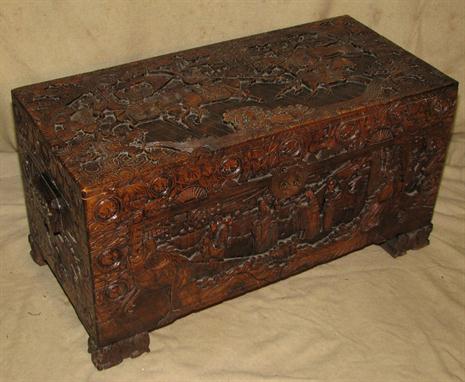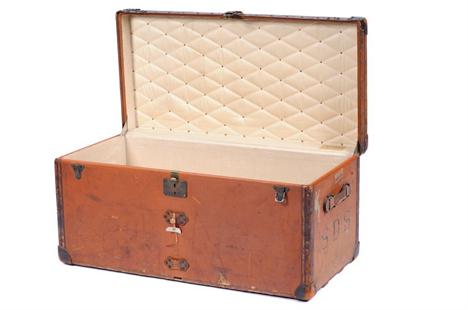We found 66887 price guide item(s) matching your search
There are 66887 lots that match your search criteria. Subscribe now to get instant access to the full price guide service.
Click here to subscribe- List
- Grid
-
66887 item(s)/page
Crete, Gortyna, stater, c. 330-270 BC, Europa, semi-nude, seated facing in plain tree with trunk in the form of left-facing bull’s head, raising veil toward her head with right hand and with left holding eagle with spread wings on her lap, rev., bull standing left with head turned back to ward off fly from his left rear hoof, 11.52g, die axis 7.00, the finest of apparently only three known examples of this variety, extremely fine and of the highest rarity, of exceptional qualityReferences: Kunstfreund 206 = Nomos 1, Zurich, 6 May 2009, 89, same dies; Svoronos 85 (a worn and pierced example in the Royal Coin Cabinet, Utrecht), same dies; BMC -; Le Rider -. Provenance: Purchased Spink, 30 June 1965. Note: This is certainly one of the finest known staters of Gortyna depicting Europa with, unusually, Zeus in his two disguises on the obverse, both as an eagle and as a bull. A different, less powerful, die is known of the same type (as Svoronos 84 and BMC 30) which is combined with a more conventional bull on the reverse. Cretan coins of the 4th and 3rd centuries were overstruck on coins brought back to the island by mercenaries returning from abroad. Consequently they are normally found in indifferent state with traces of the undertypes interfering with the local designs which mostly represent Cretan mythology. The present coin and the stater of Phaistos in the following lot distinguish themselves as being carefully struck on flans that show no evidence of overstriking (although the broadness of their flans suggests otherwise).
Nichols, Newport, a Georgian mahogany longcase clock having an eight-day duration movement striking the hours on a bell, the twelve-inch silvered arched dial engraved with black Roman hour numerals and subsidiary seconds & date dials, with the maker’s name engraved within the arch ‘Nichols, Newport, Isle of Wight’, the pagoda-topped mahogany case having a double plinth and shaped panel to the base, with the trunk having an arched door, fluted quartered columns with brass capitals, having reeded and brass stop-fluted columns to the trunk with brass reeding. height: 246cm. * Peter Nichols is recorded as working in Newport, Isle of Wight circa 1770.
Angel Sparke, Plymouth, a ‘rocking-ship’ longcase clock having an eight-day duration movement striking the hours on a bell, with additional alarm work to the side, the 11½ inch silvered arched dial engraved with black Roman numerals and subsidiary seconds dial, date aperture, blued steel hands and alarm setting disc to the centre, engraved with rococo decoration to the four corners and signed to the dial centre ‘Angel Sparke, Plymouth’, the arch having a rocking ship automaton with a sea-battle scene painted behind, the mahogany case with fluted canted corners and an arched door to the trunk, fluted columns with brass capitals to the arched hood and surmounted by three brass ‘eagle & ball’ finials, height: 214cm. * Angel Sparke is recorded as working in Plymouth from before 1792 when it was reported in the Exeter Gazette that ‘some villains broke open the shop of Mr. A. Sparke, watchmaker of Plymouth and plundered it of several articles’. The St. Andrews Church of Plymouth records him working on the church clock between 1786 and 1797 and he was known to be working at Market Street in 1814.
Jo. Heywood, Northwich, an oak and mahogany moon-phase longcase clock having an eight-day duration movement striking the hours on a bell, the fourteen-inch square painted dial having black Arabic hour numerals and outer five-minute numerals, with figures depicting the four Continents painted to the corners, decorative brass hands, a large moon-phase aperture to the centre and maker’s name ‘Jo. Heywood, Northwich’, with the falseplate stamped with the dialmaker’s name ‘Wilson’, the oak case having a shaped top to the crossbanded trunk door, gadrooned pillasters to the edges, the base with canted corners and a shaped raised panel, the flat-top hood having a swan-neck pediment with brass paterae and fluted pillars having cast brass capitals, with various inlays and stringing to the remainder of the case, height: 217cm. * Jo. Heywood appears to be unrecorded although there are a number of other Heywood’s recorded in the clock trade in Northwich, Cheshire. * James Wilson was a pioneer of the painted ‘enamel’ dial having started his manufactory in Birmingham in circa 1772 in partnership with Thomas Osborne when he was aged about seventeen and Osborne about twenty. An advert from Aris’s Birmingham Gazette in 1772 describes the partners making ‘White Clock Dials in Imitation of Enamel, in a Manner entirely new’, being the new style of painted dial that was to become so popular. On the dissolution of the partnership in September 1777 James Wilson set up on his own account at 11, Great Charles Street before enlarging into number 12. Wilson died in 1809, aged 54, and his business effectively went with him after a relative of his wife, Nathaniel Porter, tried unsuccessfully to run it before going bankrupt in 1811.
A Louis Vuitton leather bound rectangular trunk, no 502780, the hinged top with brass lock inscribed Bte S D D G Patent, Louis Vuitton, 1 Rue Scribe, Paris and 149 New Bond Street, having padded underside, the interior with lift out tray and Louis Vuitton label, 112cm (3ft 8in) x 56cm (1ft 10in) x 54cm (1ft 9¼in).
John Joyce, Ellesmere. A George III longcase clock, the arched dial painted with moon phases and with a silvered chapter ring, with eight day striking movement, the mahogany case with turned brass finials, shaped hood with turned pillars and fret frieze, the trunk with a panelled door and base on bracket feet, 268cm high overall.
A modern oak cased long case clock with moulded cornice over a glazed arched door and glazed door to the main trunk and further arched panelled door to the base, the musical movement with brass arched dial, the chapter ring with Arabic numerals within roundels surmounted by a moon phase arch and inscribed "Intern clock"
An early nineteenth century mahogany North Country longcase clock, the movement of month duration, striking on a bell, the arched painted 14in dial decorated a coursing scene to the lunette and sporting scenes to the corners, the centre with subsidiary seconds and calendar dials inscribed Don (?) YORK, having Roman numerals, the hood with carved florettes to the swan neck pediment, the glazed door with lined pillars, the trunk with marquetry oval shell and satinwood banding to the shaped top door, angled blind fretwork corners, the base inlaid a sunflower, petal corners and satinwood banded panel, a shaped frieze on bracket feet. 7ft 10.5in (240cm).
A mid nineteenth century Welsh oak longcase clock, the eight day movement striking on a bell, having a painted arched 12in dial with subsidiary seconds dials and calendar aperture, Roman numerals, inscribed David Evan Llangonoyd, gilt flowers and painted fruit corners, the hood with mahogany banding, ebonised swan neck pediment with brass rondels and brass eagle ball finial, glazed door with brass capped turned ebonised pillars, the trunk with rosewood banded doors and mahogany veneered panels, brass Corinthian capped turned ebonised pilasters, the banded base on bracket feet. 7ft 3in (221cm).
An early eighteenth century Salisbury longcase clock, the eight day five pillar movement striking on a bell, having a square brass 12in dial with subsidiary seconds dial and calendar, the chapter ring with Arabic and Roman numerals, inscribed Tho. Wentworth Sarum, the feather edge border with pierced cast gilded corner spandrels of cherubs supporting a Royal crown, the oak and pine case having a hood with pierced fretwork frieze, the glazed door with side pilasters, the trunk with a door, a base on moulded plinth. 6ft 5.5in (202cm).
A Chinese bronze censer, probably 19th Century, the circular body cast with lotus flowers and tendrils beneath a key fret rim, raised on three elephant head and trunk legs, with carved hardwood stand, together with a Chinese turquoise and blue streaky glazed vase, a Japanese polished bronze vase and a relief moulded globular vase.
A large scale model yacht "Gem", late 20th century, painted wood construction with planked deck detail including four crew and dinghy on davits, two masts with sails, electric motors to control propellor, rudder and sails trim, radio controlled multi channel unit in case, 54 1/2" long, 18" high, (deck to bottom of keel), housed in solid timber trunk with fitted interior and wrought iron hinges and other fittings, 64" long overall
A George III mahogany longcase clock by Robert Robertson, Perth, the arched dial painted with allegorical figures reprsentative of The Elements, circular face with Roman numerals, subsidiary seconds and date dials, eight day, two train movement with bell striking, the inlaid trunk with quarter pilasters above a square base and ogee bracket feet, 216cm high.
A George III mahogany and oak crossbanded longcase clock, the painted dial signed John Blaylock, Carlisle, with subsidiary second hand dial, thirty hour movement and painted scene of a sinking ship in the arch, the hood with swan neck pediment, centred by gilt metal rosettes, arch door and columns with brass capitols, the trunk canted corners and plain door with brass bun handle raised on a stepped plinth base, 220cm high.
-
66887 item(s)/page













































